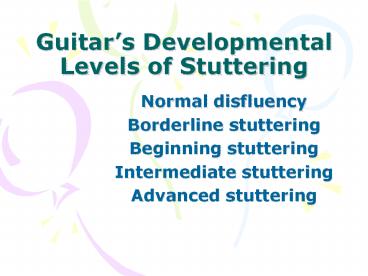Guitar - PowerPoint PPT Presentation
1 / 19
Title: Guitar
1
Guitars Developmental Levels of Stuttering
- Normal disfluency
- Borderline stuttering
- Beginning stuttering
- Intermediate stuttering
- Advanced stuttering
2
Normal disfluencyCore behaviors
- Repetitions
- part-word, single-syllable words, multi-syllabic
words, phrases - Interjections
- Revisions
- Prolongations
- Tense pauses
- (Most common are in bold)
- No more than 10 per 100 words
- Typically 1, sometimes 2-unit repetitions
3
Normal disfluencySecondary behaviors
- Escape behaviors NONE
- Avoidance behaviors - NONE
4
Normal disfluencyFeelings and attitudes
- No evidence of negative feelings in response to
disfluent moments
5
Normal disfluencyContributing factors
- Lagging speech-motor control
- Language acquisition demands
- Interpersonal stressors
- Vacations
- Hospitalizations, etc.
6
Borderline stutteringCore behaviors
- Repetitions
- part-word, single-syllable words, multi-syllabic
words, phrases - Interjections
- Revisions
- Prolongations
- Tense pauses
- (Most common in bold)
- More than 10 per 100 words
- More than 2units in repetitions
- Repetitions and prolongations are loose and
relaxed
7
Beginning stutteringCore behaviors
- Repetitions
- part-word repetitions that are rapid, irregular
with schwa insertions and pitch changes - Prolongations with pitch changes
- Hard blocks
- Fixed articulatory posturingLaryngeal blocks
- More than 10 per 100 words
- More than 2 units in repetitions
8
Borderline stutteringSecondary behaviors
- Escape behaviors FEW or NONE
- Avoidance behaviors NONE
9
Borderline stutteringFeelings and attitudes
- Little or no evidence of awareness
10
Beginning stutteringSecondary behaviors
- Escape behaviors Extraneous physical behaviors
performed in an effort to push the word out
(squinting eyes, nodding head backward, etc.)
use of fillers (starters) like um to help
release the stuttered word - Avoidance behaviors NONE
11
Beginning stutteringFeelings and attitudes
- Frustration, out of control, and some fear
- Positive overall self-concept
12
Beginning StutteringContributing factors
- Interplay between constitution factors and
environmental factors
13
Intermediate stutteringCore behaviors
- Prolongations with pitch changes
- Hard blocks
- Fixed articulatory posturingLaryngeal blocks
- Repetitions
- part-word repetitions that are rapid, irregular
with schwa insertions and pitch changes - More than 10 per 100 words
- More than 2 units in repetitions
14
Intermediate stutteringSecondary behaviors
- Escape behaviors Extraneous physical behaviors
performed in an effort to push the word out
occur more frequently and are performed more
rapidly - Avoidance behaviors word avoidances
(substitutions, circumlocutions, anti-expectancy
devices, etc.), and situation avoidances
15
Intermediate stutteringFeelings and attitudes
- Fear, shame, embarrassment, and guilt
- Negative self-concept
16
Intermediate StutteringContributing factors
- Constitution factors and environmental factors
- Classical conditioning
- Avoidance conditioning
17
Advanced stutteringCore behaviors
- Hard blocks
- Fixed articulatory posturingLaryngeal blocks
- Prolongations with pitch changes
- Occasionally, core behaviors are fewer because of
an increase in avoidances - More than 10 per 100 words
- More than 2 units in repetitions
18
Advanced stutteringSecondary behaviors
- Avoidance behaviors word avoidances
(substitutions, circumlocutions, anti-expectancy
devices, etc.), and situation avoidances - Escape behaviors Extraneous physical behaviors
performed in an effort to push the word out
occur more frequently and are performed more
rapidly
19
Advanced StutteringContributing factors
- Classical conditioning
- Avoidance conditioning
- Habitualized patterns
- Constitution factors and environmental factors































